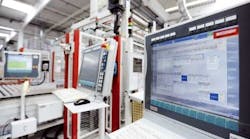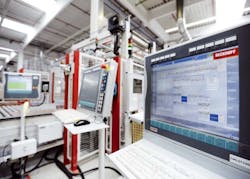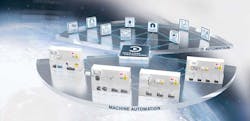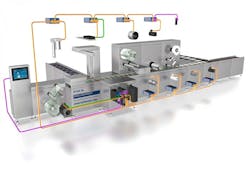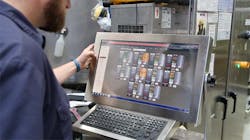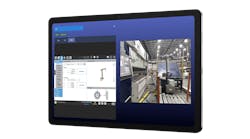Those who’ve been in automation industries for years have certain ways they like to design and program machines. They have baseline schematics or system architectures they always start with—they have always done machine control that way.
The fruit of those in automation doesn't fall far from the tree, and it doesn't ripen or spoil quickly. Change takes time, but now is the time to define a new and better hardware and software recipe. What ingredients must be added to the mix for a great machine-control system, and what will be needed for future recipes?
As automation opportunities advance with technology, what are the critical main components in a machine control system? What drop-in black boxes can we make to advance automation? Technology is making machine control better, and users have high expectations. There are guidelines for success today and continued success in the future.
Historic and reused
"Machine control historically has consisted of an industrial programmable logic control (PLC) programmed in ladder logic with a PLC touch panel display, providing the human-machine interface (HMI) to the tool," says Doug Putnam-Pite, director of software development at Owens Design (www.owensdesign.com) in Fremont, California. "The PLC and PLC touch panel are often provided by the same vendor. This programming paradigm is reminiscent of developers writing assembly-language programs before the advent of C or C++ programming languages. Before the advent of higher-level programming languages, each tool or processor had its own version of assembly language."
If we want to have great machine control, then we need to have great software development tools. "Too often it seems that control programmers are stuck in the weeds, spending way too much time figuring out how to toggle I/O bits, rather than providing enhanced tool features and performance," says Putnam-Pite. "As an industry we need to move away from proprietary software development environments and move to nonproprietary development tools. Developers should be able to write control code using high-level languages that can be used across multiple control platforms. In other industries it is now possible to write code on one platform and deploy the executable software on multiple platforms. Using higher-level programming languages allows for greater software reuse and allows the developer to concentrate on providing enhanced functionality."
With machine control, the basic components and system architecture remain a part of a tried-and-true design and are part of the definition of machine control. "The critical main components in a machine control system can include the signals from sensors, actuators, instrumentation and devices onboard the machine," says Arun K. Sinha, engineer with Opto 22. "These are interfaced to I/O modules on a controller. Tasks and operations are broken down and organized in the controller software, typically referred to as a program or strategy. Often a human-machine interface allows operators to interface with the machine in graphical format."
Open and communicating
"Fortunately for machine builders, the ingredients for a good hardware and software recipe are available today," says Aurelio Banda, president and CEO at Beckhoff Automation. "In general, basing your machine design on open platforms in all areas—hardware, software and networking – represents a big leap toward a future-ready machine. Openness is a key attribute of PC-based control platforms, which also offer a wide range of available tools that cover all standard PLC programming languages, including their object-oriented extensions. This makes it possible for machine builders to implement object-oriented programming methodologies, which enable the creation of much more intelligent and autonomous machinery. PC-based control systems are also likely to implement widely used computer science tools for use in controls engineering (Figure 1)."
Figure 1: Open platforms, including hardware, software and networking, are a big step toward a future-ready machine.
(Source: Beckhoff)
No one is saying that a machine builder needs to use all of these tools, but it is critically important to have them accessible. "This way, PLC programmers can work side by side with IT and computer science programmers on the same machine control projects, greatly widening the pool of available engineering talent for OEMs," says Banda. "Beyond the core staples of machine control, benefits extend to the implementation of real-time data acquisition and analytics solutions."
One of the biggest ingredients to machine control success is communication. "More and more, every piece of the automation stream is being asked for more information, from a simple proximity switch all the way up to a high-end machine controller," says Allen Tubbs, product manager, IoT, at Bosch Rexroth (www.boschrexroth.com), a member of the Control System Integrators Association (CSIA). "This data is used to bring value to all areas of manufacturing to improve efficiency, enhance safety and optimize value streams all around a manufacturing enterprise (Figure 2)."
Figure 2: Tying together all areas of manufacturing to improve efficiency and safety and optimize the value stream requires data and open standards communication.
(Source: Bosch Rexroth)
Open standards communication is needed to accomplish this. "The more a data stream is proprietary, the less useful it is to others," says Tubbs. "Open standards such as OPC UA are breaking down these barriers as more vendors adopt them, and that is freeing up data flow between devices and data systems."
Real-time over standard Ethernet is also needed. "High-speed, deterministic communications over standard Ethernet media will help move data where it needs to be at lower cost," says Tubbs. "Time-sensitive networks (TSNs) will help by providing a data communication path over standard Ethernet architecture. Wireless advances such as 5G will improve the speed and volume of data that can be transmitted."
The increasing demands on production quality and throughput, along with digital connectivity between processes, are leading to a step increase in manufacturing complexity, says Sanket Amberkar, senior vice president of marketing at Falkonry. "One way to meet the demand, as seen in semiconductor and automotive manufacturing, is the increased usage of data-driven techniques," he says. "Future recipes for successful machine control are therefore certain to include hardware and software to support analytical tools that guide process decisions. Just like PLC and statistical process control introduced industrial automation; operational machine learning and predictive analytics will be the backbone of Industry 4.0."
Starting a trend
Where do automation technology trends start? "Look to technology-driven industries with plenty of R&D investment, a need to make things move and the impetus to push the envelope," says John Kowal, director, business development at B&R Industrial Automation. "You’ll find IT, automotive, aerospace and military at the top of the list."
We are going to have some very smart and educated people developing new systems that can be used with little or no specialized skills, continued Kowal. "That goes for everything, and for machine control systems, too," he says. "Cars are showing up at the Consumer Electronics Show because of their electronic content."
Your car tells you when your left rear tire is low on air. The car company calls you in your car to schedule a service appointment at the dealer. The dealer technician reads the diagnostics and gets step-by-step instructions.
"When you operate your car, you are operating multiple computers over a CAN—and soon to be TSN—network," says Kowal. "Automotive is where we got CANbus, after all. And TSN started out as a video/entertainment communication protocol. Aerospace and military gave us the Internet, GPS and autonomous vehicles, including drones."
One area of advancement—a trend—is the focus on data analytics. "A use case with a lot of visibility is predictive maintenance," says Opto 22’s Sinha. "Predicting a machine condition or failure before it occurs is preferred over traditional preventive or scheduled maintenance. Data analysis tools that do things like anomaly detection, classification, clustering and algorithms based on regression have been used in the IT space for some time and are now making their way into machine control."
A black-box solution?
Machine control is breaking down tasks and operations into modules, subassemblies and special functions. These are the building blocks to quick, capable and reliable control. There are critical main components in a machine control system, but drop-in "black boxes" may sound good but not be a best practice to advance automation.
"While the black-box idea for machine control seems attractive conceptually, it works against the customer’s objectives of long-term ease of support, squeezing every last bit of productivity out of their capital assets," says Danny Weiss, senior product manager at Newark element14 (www.newark.com). "With the vast variety of industrial applications, each machine design draws on the innovation of the builder—figuring out new and clever ways to minimize cost while delivering reliable and consistent production. Essentially, every machine made by an engineering team, outside the customer’s own, is a black box.
However, control panel designs could provide black-box solutions, saving time. "Standard panel designs from the PLC suppliers would be a huge step forward," says David Paul, engineering design manager at Maverick Technologies, a Rockwell Automation company and a member of CSIA. "In the automation world, almost every panel is a custom design. Standard panel designs are very common in distributed control systems. For PLC-based systems, a standard panel design could reduce cost, increase assembly accuracy and improve delivery times for control systems. These offerings could be provided in various standard enclosure sizes depending on the size of the PLC I/O rack installed in the enclosure."
A black box may be easy to create when the quantity needed is high, but, sometimes, with lower quantities of systems needed, simplicity is the key. "We see a distinct difference between the requirements for low-volume products vs. high-volume," says Gary H. Lucas, director of innovation at Innovative Treatment Products (www.innovatreat.com) in Owings Mills, Maryland. "For low-volume products the programming software capability is much more important than the hardware cost. We use Do-more controllers because the software gets the programming done quicker, saving us lots of money over cheaper hardware. For high volume, you can tolerate a more cumbersome programming environment if the hardware is inexpensive."
Innovative Treatment Products’ Lucas is not crazy about black box solutions and programmable hardware. "Intuitive programming is all in the mind of the software designer," he says. "We prefer discoverable functionality. Finding the right cable, software and even computer for a device a couple years down the road is really a problem. We’d prefer devices be programmed by the main controller. PLC modules programmed by the PLC, variable-frequency drives programmed over Modbus by the PLC software, for example."
A black-box, decentralized approach may simplify configuration options. "A new decision needs to be brought into the mix in terms of centralized vs. decentralized control," says Bob White, training and digital services manager at Kollmorgen. "Based on the size of the machine, distances between axes and control cabinet locations, it may make sense to use a decentralized approach, mounting power electronics close to the motor source to minimize cable runs."
White explained that by using a decentralized approach, a machine designer can plan on developing multiple machine configuration options that can be added easily to the end of the network of distributed servo drives (Figure 3).
Figure 3: A decentralized approach, such as distributed servo drives, can make it easy to create multiple machine configuration options.
(Source: Kollmorgen)
Better ingredients, better control
"A better approach to designing control systems needs five main ingredients,” says Chris Como, portfolio manager, motion control business, Rockwell Automation. "The first is a productive design environment—one that can abstract a machine’s hardware from its software so the designer can adapt the solution to different machine types. Now, the designer isn’t constantly reinventing the wheel and can instead focus on innovation for the solutions."
The second ingredient is smart devices. "Plug-and-play devices that auto-configure can help with commissioning and startup," says Como. "And devices like load observers can aid a machine’s overall lifecycle. These devices can monitor and adapt to system disturbances and, in many cases, alert operators that something has happened to the system’s nominal operation."
Third is analytics. "The Gartner Analytic Ascendancy Model is becoming more prevalent today in helping system designers and end users better understand how to improve their processes," says Como. "Descriptive analytics help explain what happened and diagnostic analytics explain why it happened. Predictive analytics go even further by detailing what will happen and prescriptive analytics lay out how to make it happen. All these analytics used in conjunction, in total or in part, can provide powerful insights into machine control."
Fourth is the growing desire to safely operate and interact with machinery. "Safety sells, and end users are seeing the multiple benefits of safely interacting with their machines, like improved productivity and greater innovation in areas like collaborative robotics," says Como.
The fifth ingredient is the open and secure data flow between the various pieces of a control system. "Security is a major requirement in industrial automation systems today," says Como. "As control systems open themselves up for better data exchange, they must be able to guard the integrity of their data."
More capable HMIs
"Each system is different, but one often-overlooked area of focus for machine control is the HMI screen design," says Kevin McClusky , co-director of sales engineering at Inductive Automation, a member of CSIA. "While the engineering in the system is paramount to get right, if a user has trouble controlling the system or understanding how to turn the knobs, some of that engineering work and fine tuning when designing the system will probably go to waste. Plus, that interface is part of your reputation, as it will often be a place your logo is visible and will act as the visual portal to the machine. If a user hates the screens, they may end up having a negative view of your company. It can be worth either bringing a member of your marketing team or short-term contracting a user interface/user experience (UI/UX) designer to help create a simple, usable, modern visual interface (Figure 4)."
Figure 4: It's worth the time, effort and cost to develop an HMI that is easy to understand and operate, or the operators may have a negative view of your company or equipment.
(Source: Inductive Automation)
Programming tools are doing some of the work for the programmer, but they could do more. "Most modern PLC/HMI programming tools allow tag sharing between the PLC and HMI devices, so things don’t have to be defined or entered redundantly," says Rick Lamb, president at MidTechV, a technology-focused system integrator in Indianapolis. "Every system needs tools to monitor and force I/O points during startup and troubleshooting."
Why don’t vendors have a software module that can auto-generate HMI screens to monitor and possibly override or force every PLC I/O point in the system? "Then instead of needing an engineer to connect a programming terminal, the I/O status can be monitored from the HMI screen, and without having to open the control panel door to look at the I/O card lights," says Lamb, "and without the engineer having to create such a screen from scratch."
Likewise, there should be a predefined HMI diagnostic page automatically configured to monitor all the parameters in a configurable attached device, continues Lamb. "When you configure an HMI and a PLC into a system, the software should automatically generate a screen to show the status of the PLC health, battery, cycle time, real-time clock and any other parameters internal to the PLC," he says. "Likewise, if you add a VFD to the system, there should be an auto-generated page that shows all the configuration parameters of the VFD."
Finally, says Lamb, "I’d like the ability to auto-generate an HMI screen with tables of tag values—something like a spreadsheet showing tagname, value and other parameters—not in the programming software but automatically created as a page or screen for the HMI terminal."
Organizing tasks can help simplify machine control, and getting to the information is part of that. "Fanuc has been developing controls since 1956 and learned a lot of valuable insights along the way, so when Fanuc developed the new Fanuc iHMI platform, it leveraged this knowledge and experience while taking on a new approach to interacting with a CNC," says Paul Webster, manager, CNC engineering, at Fanuc. "One of the most noticeable differences in the new platform is not necessarily a new feature or ingredient, but how much simpler it is for people to get the information they need. Machining hasn’t changed; the same data is required. We just want to make it easier and more intuitive to get and work with that information (Figure 5).”
Figure 5: Data is still data. It’s now just easier and more intuitive to get and work with by having planning, machining and improvement sections.
(Source: Fanuc)
One of the ways Fanuc did this was to segment things into three sections: planning, machining and improvement. "All the data entry, reporting and operational tool for these functions are grouped together, so an operator easily knows where to go to get information or accomplish a task," says Webster. "While there are some familiar reflections of the familiar Fanuc system, most people will find the whole system easier to work with."
Moving forward
"As we move further into the digital age, the IIoT evolution will continue to gain traction worldwide, individual hardware components become more of a commodity and the connectivity of those components to the overall industrial control systems that they are a part of delivers the real value," says Simone Gianotti, EcoStruxure industry business development manager at Schneider Electric (www.schneider-electric.com). "For machine builders to differentiate themselves, they must begin by standardizing their machine designs with the embedded software functionalities of tomorrow. The cutting-edge software advancements like digital twin technology, augmented reality and machine performance analytics will soon be expected from end users; and they will expect it to be easy to use."
End users need machines that will stand the test of time, so it is critical that any embedded software be hardware-agnostic. "This ensures that the software will continue to deliver results throughout the lifecycle of the machine as hardware components are replaced during maintenance or machine upgrades," says Gianotti. "Also, it is not enough to only provide a superior machine with high-quality components and intelligent software. End users need an intuitive user interface to bring the full potential of the machine to their fingertips, locally and remotely, from the start. Spending the time up front to design interfaces that are simple to understand and easy to use will empower the user to make the most of the machine quickly. This will also increase uptime over the machine’s lifecycle by providing real-time machine performance data, quickly diagnosing error messages and sending routine maintenance alerts saving the user time and money through the machine’s efficiency."
